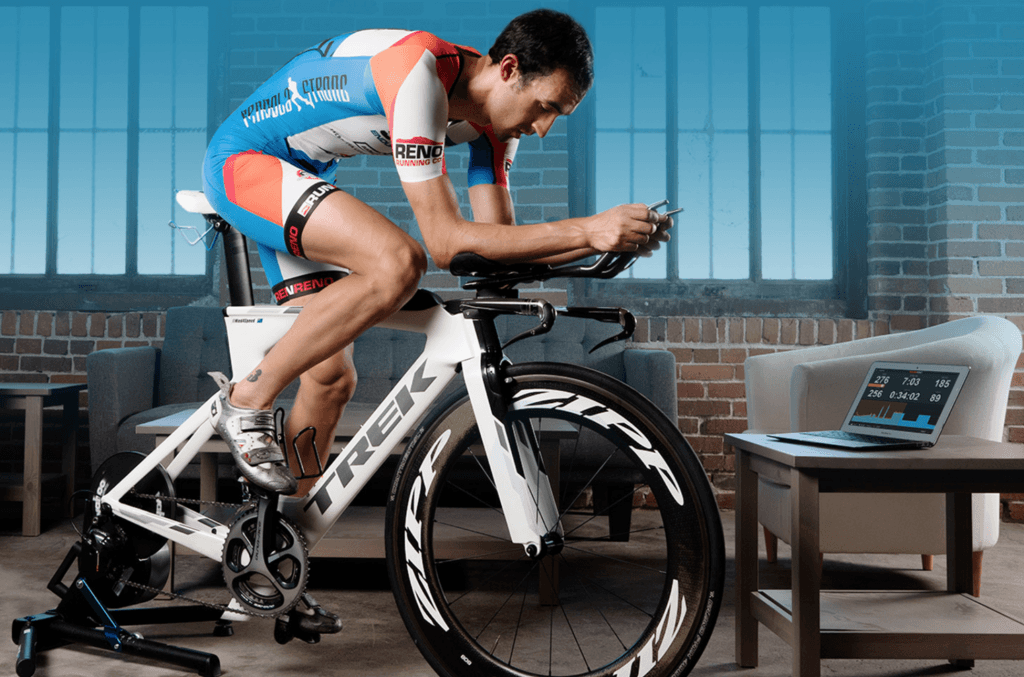The days of riding indoors on a spin bike on long gone. Triathletes now have countless options for training indoors, and many choose to train indoors on the bike year-round. For some it’s about safety, but for most of you it’s simply about effectiveness: you can’t beat a workout with no stoplights, exact pacing, and proximity to a bathroom!
In all seriousness though, dialing in your indoor workout set up has huge upsides. It makes training easier. You’ll have a better workout. And you’ll likely be faster on race day.
Here are some ways that you can train indoors on your bike like Endurance Nation athletes do.
Standardize Your Warm Up
For the longest time I thought warm-ups where joke. Of course, I was in my late twenties and could fully appreciate the benefits of being muscularly ready to train. I now know that my first mile is often my worst mile. Once I’m warmed up I can still train at peak levels.
However, knowing that you need to warm up isn’t enough. Creating a fixed warm-up will allow you to do much more than just get ready for your next workout — it can help you determine just how ready your body is to train.
Endurance Nation athletes warm-up for about 25 minutes on the bike. The standard cycling warm-up is as follows:
- 5 minutes easy;
- 3 minutes standing @ big gear/low cadence;
- 2 minutes easy;
- 8 minutes at Zone 3 or Half IM effort (about 80 to 85% of Functional Threshold Power);
- 2 minutes easy.
By monitoring the eight minutes in Zone Three (approximately Half Ironman effort), you’ll get an Average Heart Rate and perhaps a Power number. By comparing that number to today’s warm up, you’ll know if your heart rate is higher than normal. You’ll notice if your power is crazy low, making it hard to get to the typical numbers. In either case, the planned workout likely shouldn’t happen.
While most athletes benchmark off of a four- or eight-week test cycle, using this workout will allow you to get several data sets per week. It will allow you to track overall fatigue and performance improvement better than almost any piece of software!
Work First, Time Second
One of the biggest mistakes triathletes make is simply using time or distance covered as the baseline metric for their training. While those numbers are great to track, they really don’t get at the true nature of the workout that you’re doing.
Inside Endurance Nation all of our workouts look like weightlifting sets:
- 3 × 8’ (2’) @ Zone 4 / Threshold, aka…
- Three sets of eight minutes at Threshold with two minutes of recovery after each, aka…
- Twenty-four minutes of work in a very detailed training session on the bike!
Since all of our workouts are written this way, everyone knows exactly what work they need to accomplish in that training session. It could take them half an hour to get it done quickly or they could extend it up to an hour if they so choose. Bottom line — as coaches we only care about that Main Set. Do yourself a favor and focus on the most critical portion of your workout first, after that you are free to track the time or distance.
Fix the Work, Increase the Effort
One of my favorite hacks as a coach is to not consistently move the workout needle up but rather let the athletes push themselves.
Most training programs increase training time or training intensity from week to week. That’s how fitness is created: You work harder, then recover, then get stronger.
But moving from 12-minute intervals to 14-minute intervals all the way up to 20-minute intervals over sequential weeks isn’t easy. It’s tough physically and mentally.
Rather than trying to increase your time at a given effort, you can fix the time and increase the effort with each interval. For example, rather than trying to ride increasing intervals at a fixed 250 W, I can ride 10 minute intervals every week and try and move that 250 W higher each week.
| Weeks | Traditional Way | Alternative Way |
| One | 3 x 10 minutes at 250W | 3 x 10 minutes at 250W |
| Two | 3 x 12 minutes at 250W | 3 x 10 minutes at 255 W |
| Three | 3 x 14 minutes at 250W | 3 x 10 minutes at 260W |
| Four | 3 x 16 minutes at 250W | 3 x 10 minutes at 265W |
Sitting on a fixed interval each week and watching the Watts go up (or the distance covered if you don’t have power) is motivational and empowering. Bonus that it’s also very easy to wrap your head around at 5am on your trainer!
Set Up the Night Before
This one sounds simple and yet so few people actually do it. If you had a five-hour ride on the schedule tomorrow morning at 6 AM, you would spend tonight getting ready. But with just an hour on the trainer planned, you have zero incentive.
As a result, you spend precious workout time blundering around trying to find your computer, your nutrition and the appropriate clothing. We recommend you take a few minutes and continue the great habit of getting ready for a quality session.
Stay Accountable
One of the benefits of training outside is that you have a social dynamic to keep you focused. Your position relative to the group gives you instant feedback on your fitness and relative strength. And if you miss a training session, you’ll hear about it!
If you’re training indoors you can still remain accountable by using online services such as Garmin Connect and Strava to share your workout data with friends and teammates. Combining your shared workout data with instant notifications will help your friends keep you on track — or on the hot seat — depending how you have performed.
Fuel It Like Race Day
Every year I talk to athletes disappointed with their training performance on the indoor trainer. Fast forward through the dejected conversations, we suddenly discover that they haven’t actually been fueling their workouts.
Despite a season of long training sessions with great nutrition, these athletes head indoors and put away the bars and the gels and instead rely on a cop of coffee and maybe, just maybe, a part of a banana for a 90-minute training session.
Whether this is part of some sort of grand nutritional plan you have or just negligence the results are the same: your workout will suffer. It might not happen now, but it will certainly happen over time. Soon you’ll start to see the numbers drop as your ability to sustain hard efforts lessens. Eventually your body will start to underperform across the board and potentially reach overtraining or illness.
Rather than risking this outcome, you can easily treat your indoor workout like any normal in season training session. Have your nutrition ready to rock, so that your workouts are the best they can be. Stacking consecutive legitimate workouts is the fastest way to build fitness — and the most reliable way to increase your chances of race day success.
Watch Your Workout (Zwift)
One of the biggest additions to the Endurance Nation arsenal has been integrating our workouts into the Zwift ecosytem — workouts and races, that is.
All of our indoor cycing lessons have been Zwift-ified and added to your workouts in Final Surge. This is across all of our OutSeason plans and our Specificity and Race Prep plans (see the EN Roadmap).
What is Zwift You Ask? If’s training indoors on your bike meets a video game. You connect your trainer and can race, ride, and run with other athletes from around the globe. You learn all about it and how we use it as a Team on our official Zwift page.






Leave a Reply